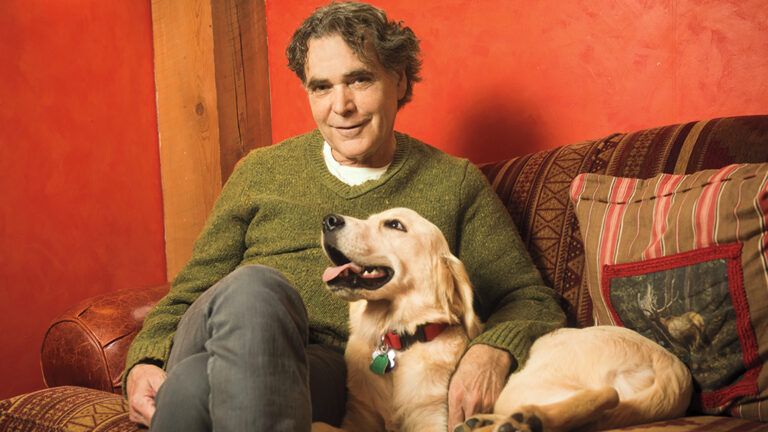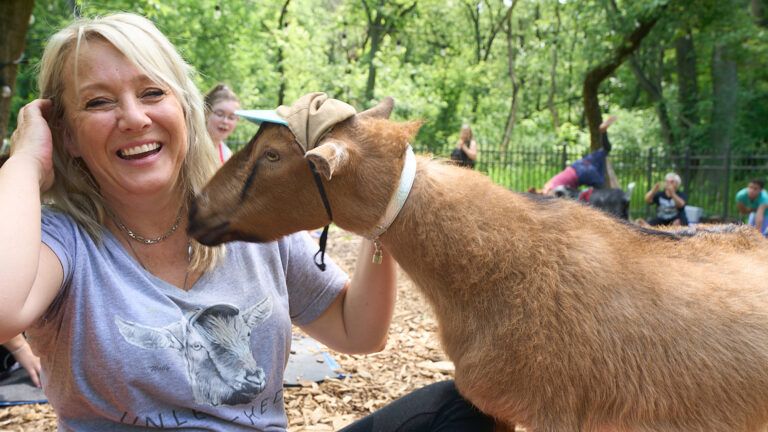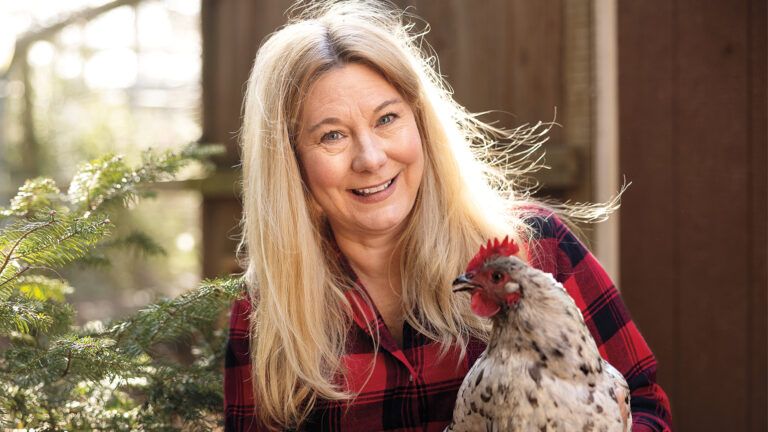Lindy nibbled at the hay I held to her mouth, then laid her head weakly on the straw inside the tentlike shelter in the pasture. She still wasn’t getting up. For four days in the February cold my three-year-old ewe had lain here, miserable, unable to give birth to the obviously huge baby (or was it twins?) straining against her swollen belly. Despite watching hours of lambing videos online, I doubted I could be the midwife she needed.
The only large-animal veterinarian in the area was out of town. The on-call vet had advised, “Just watch her.” What did he think I’d been doing? Every two hours round the clock, I’d sat with Lindy, coaxing her to eat and drink. Nothing had changed. Desperate, I’d messaged other shepherds online. “She’s been down too long to survive,” most of them said. “Put her out of her misery.” I couldn’t bear the thought.
It was 11 p.m., pitch black except for my headlamp. The Virginia mountain air froze my every breath. Lindy’s belly was so distended, she looked like a giant wad of wool with a head stuck on as an afterthought. Each time I came to the shelter I moved her legs, trying to keep her circulation going. I massaged her thighs, working my hands into her thick wool. Help me, God, I prayed—and not for the first time. Please let Lindy and her lambs live. But all I heard was the wind blowing against the canvas shelter. I was so tired, I could barely hold up my own head.
I’d been divorced for two years and lived alone in a rambling 133-year-old house. My work-from-home job as the creative director for a communications company barely left me enough to pay the bills and my youngest son’s college tuition. Most nights I cried myself to sleep, overwhelmed and not wanting to face another day on my own.
It wasn’t supposed to be this way. Buying this house in the mountains had been a dream come true for my husband and me. We’d planted flower beds together and a vegetable garden. Spent hours talking, laughing and relaxing on the old porches. Then came the animals—chickens, stray cats, even a stray pup. For me this place was a way to get back to my roots growing up in farm country in western Ohio. I was 12 when my family moved to the city of Raleigh, North Carolina, and it felt like part of me died in the process. So when I heard of six bottle-fed lambs for sale I couldn’t resist. “I’ve always wanted to raise sheep!” I said to my husband.
I imagined the fun I’d have shearing them, using their wool for art projects. I read books, talked with shepherds and fenced in part of our property. Then I bought the lambs and set about becoming a shepherdess.
A year later my husband left. “I’m tired of the responsibility” was all he said. Slowly it sunk in that the house, the porches, the gardens, the sheep—they’d been my dreams, not his. Now I was left trying to manage all of it on my own. And it seemed like every day was more of a struggle than the last.
This was Lindy’s second pregnancy. The first one had gone badly. She’d given birth to a stillborn. The mournful look she gave me as I picked up her lifeless baby was etched in my memory. She’d stared at it, then at me, then slowly walked away, her head hung low. Of my six sheep—five ewes and one ram—Lindy was the one who was unsociable. She always stood behind the others and would not let me touch her. The stillbirth only put more distance between us.
In the fall, when I’d noticed she was pregnant again, I was excited for her. My other ewes had given birth to three lambs without any assistance from me, the way sheep have done for thousands of years. But by the end of January Lindy’s belly was huge and getting bigger. Then one day I found her in the field, unable to stand. I tried coaxing her up with sweet molasses. She looked away. Finally, I grabbed her by the hindquarters, pulled her partially to her feet and led her to the shelter, where I’d been checking on her ever since.
When I wasn’t with Lindy I was scouring the internet, watching videos, reading articles, poring over forum posts by more experienced shepherds. But there’d been nothing about what to do for an expectant mother too swollen to move. Online, every birth I’d found went smoothly. Now Lindy stared at me glassy-eyed. I scratched her jawline and she murmured appreciatively. “It’s going to be okay,” I whispered, as much for me as Lindy. “We’re going to get through this.” I had to get some sleep. I kissed her good night and went inside for a couple of hours of shut-eye.
I woke with a start. It was 4 a.m. I’d way overslept. I threw on some clothes and a farm coat and ran to the shelter. Lindy was still lying on her side. But her water had broken! A four-inch tail was wiggling out of her. At last I knew the problem. The baby was breech!
I scrambled back to the house, grabbing rubber gloves, vegetable oil, a basket of sheep-shearing tools and an armful of towels. By the time I got back to Lindy, the lamb inside of her was desperately trying to get out, thrusting hard against Lindy’s belly. “Oh, you poor baby!” I cried.
I pushed the little tail back into Lindy, then reached inside her and felt for the lamb’s head. What I felt was warm, squishy and definitely not a head. Stay calm, I told myself. Remember what you read and watched. I repositioned myself and pushed my arm deeper. Still no head. Instead I felt the amniotic sac of a second lamb! I broke the membrane and fluid gushed out. I carefully pulled the lamb into the world by its head and two tiny front hooves. I gazed at its little black nose. As I touched its white muzzle, I felt it take its first breath. How amazing! Then those beautiful dark eyes looked up at me and I was smitten.
I dried off the lamb and set it in front of Lindy, but she barely lifted her head. She was losing energy fast. I peeled off the gloves, donned another pair and oiled up my hands again to deliver the breech lamb. How long had it already been trying to get out? Most lambs have only an hour to survive inside the womb after the water breaks. I was racing against the clock.
Lindy’s belly was strangely still. I searched and searched for the breech lamb’s face and front hooves. I couldn’t find either. The only thing I could think to do was deliver it by its back legs. I waited for a contraction, pulled swiftly and out it came.
But the lamb wasn’t breathing. Fighting back tears, I shook it gently. Then harder. I held it upside down and cleared its mouth. I wiped it off and compressed its chest. Nothing. The first lamb was standing and stumbling toward me as I held its twin. “God, please don’t give up on this lamb!” I shouted, rubbing its chest.
The little lamb took a deep breath and wiggled in my grasp. “Oh, thank you, Jesus!” I said as my fear and doubts melted away. I was overcome with joy. I’d never been left alone. The Great Shepherd was right there with me and Lindy and her lambs. And with his help, I could handle my job, my son’s expenses and this farm and care for all the animals who called it home.
I took off my gloves, replaced them with a new pair and used the last of the oil to deliver Lindy’s afterbirth. She didn’t have the strength to do it herself. The twins nuzzled each other as I felt inside Lindy once again. But there was something else. A third face and another set of hooves!
No wonder Lindy had been down so long. Ewes rarely have triplets. This was an incredible gift. I quickly broke the third lamb’s water and pulled it out. I cleaned off its face and rubbed it dry and it blinked at me, as if to say, “Thank you for not forgetting me.” A sentiment I understood all too well.
I’m reminded of God’s loving presence every day now as I walk out to the pasture and see Lindy and her three healthy lambs grazing next to her. When they catch sight of me, they all come running—with Lindy in the lead.
For more inspiring animal stories, subscribe to All Creatures
magazine.





